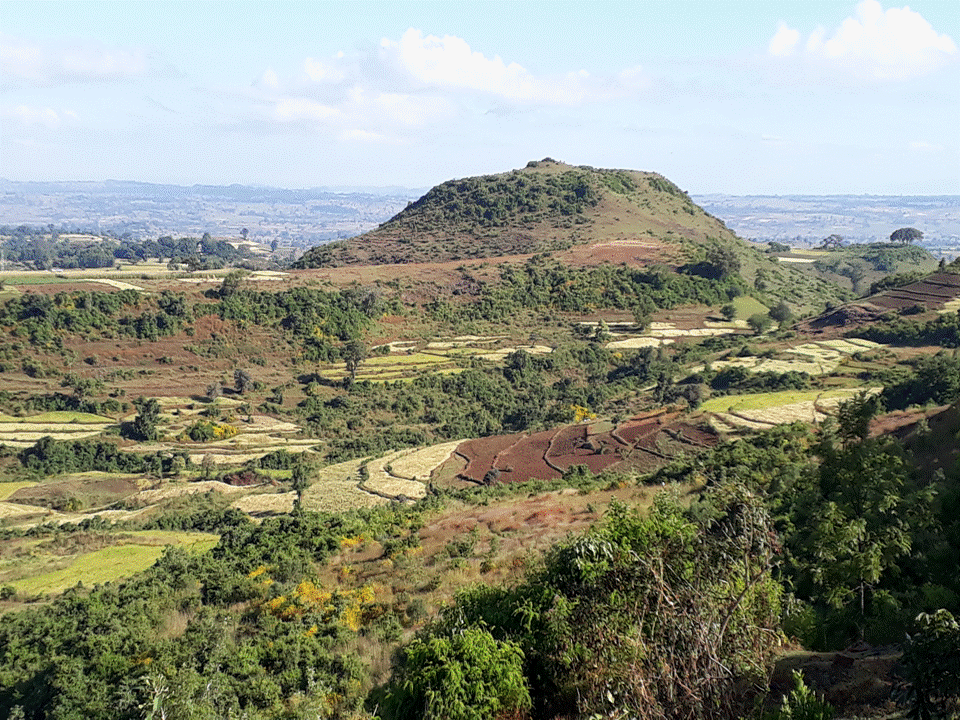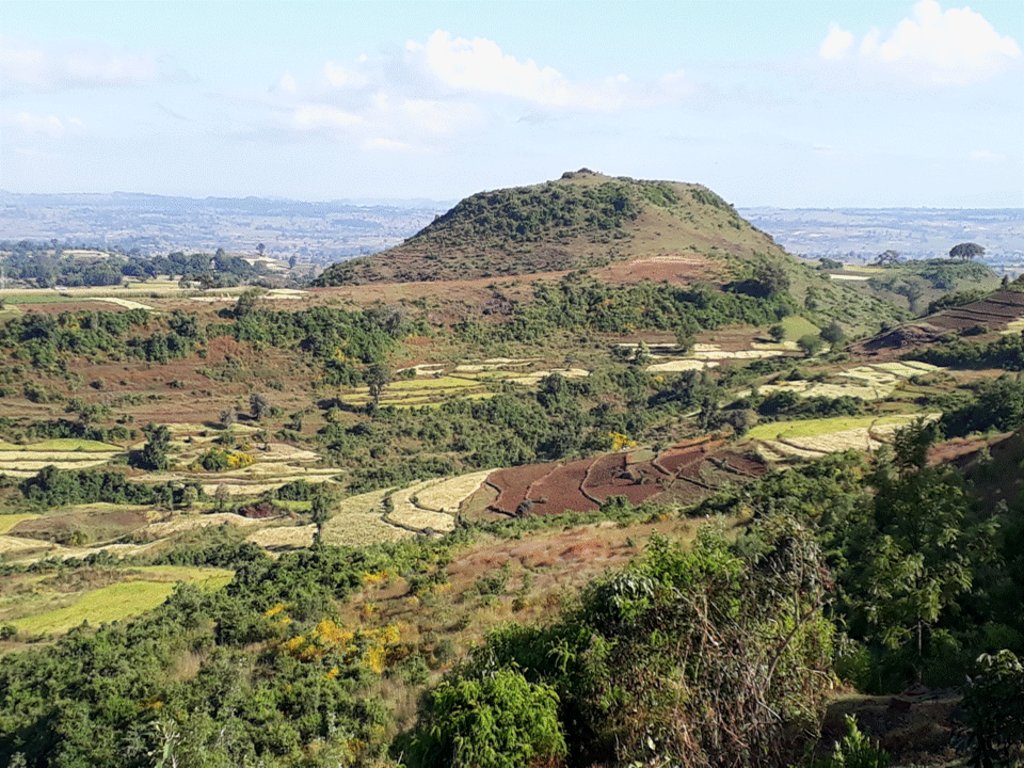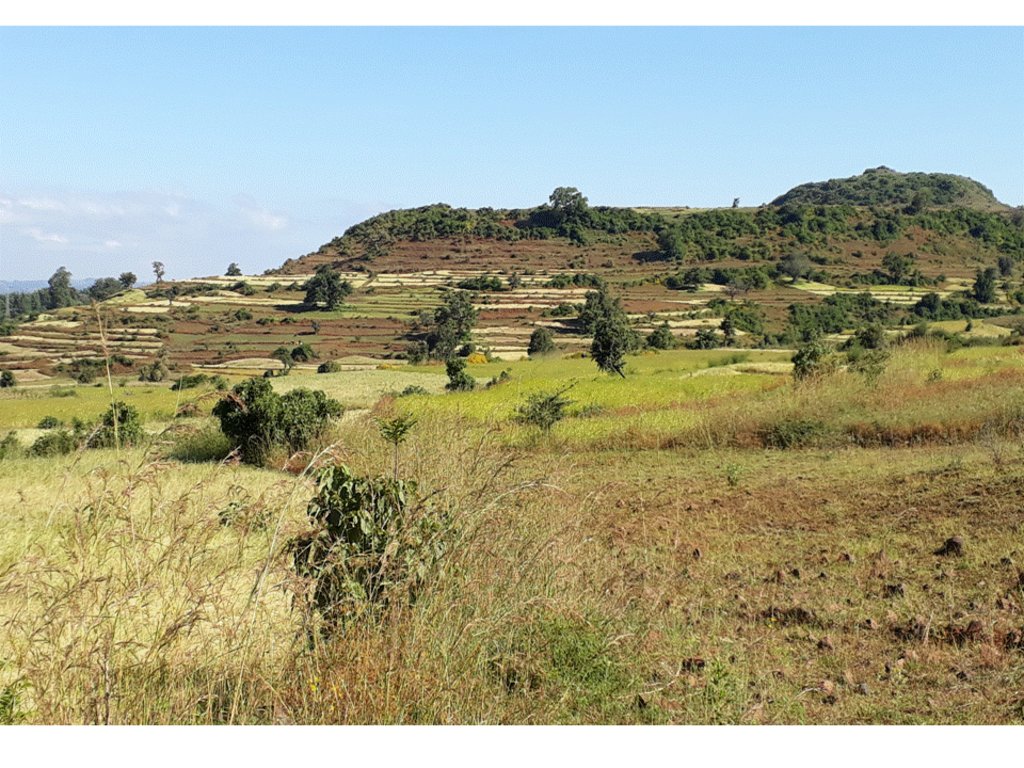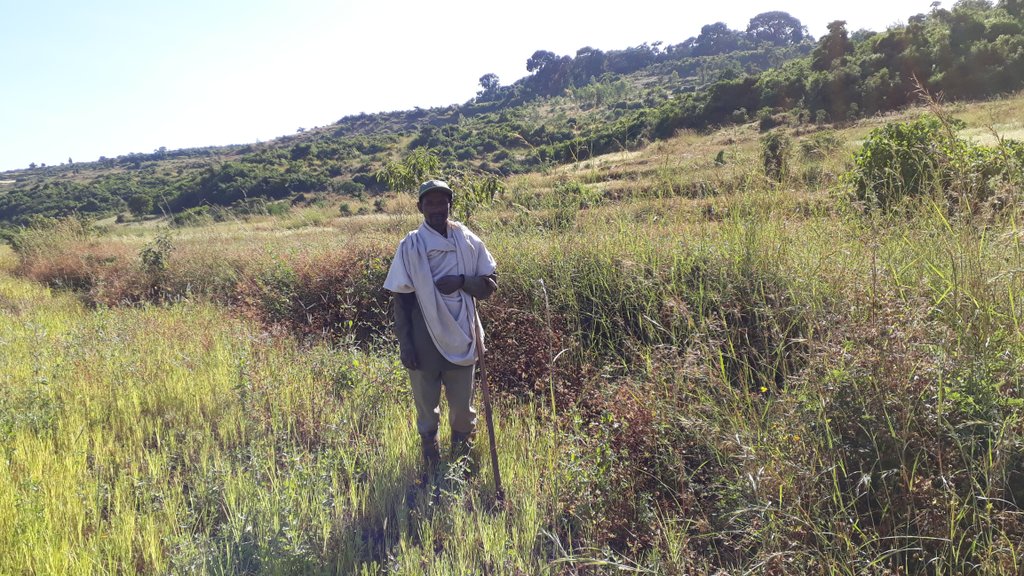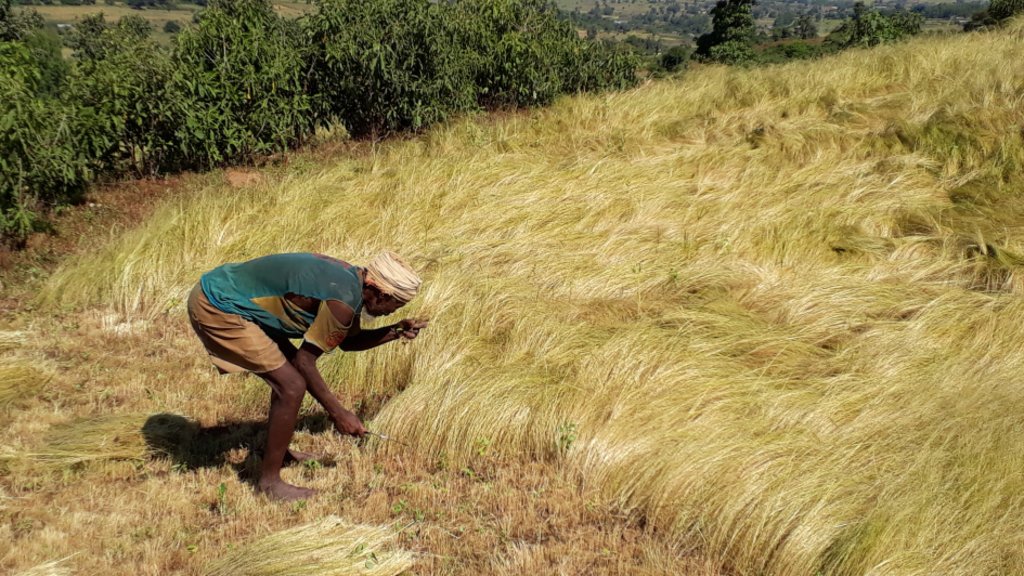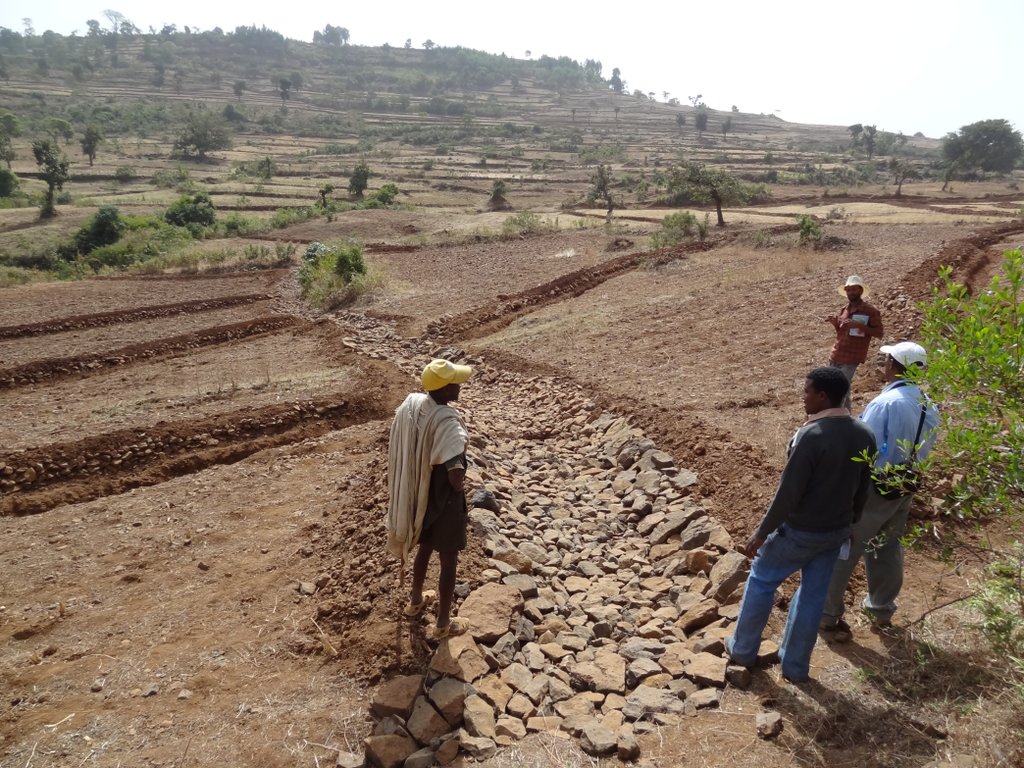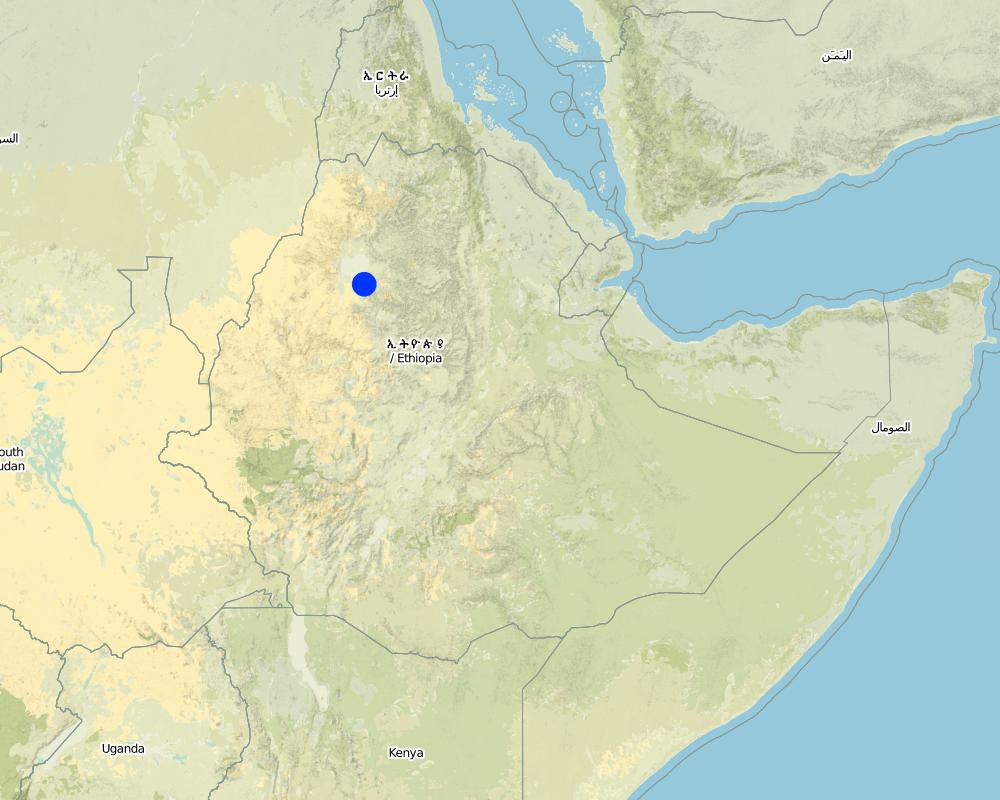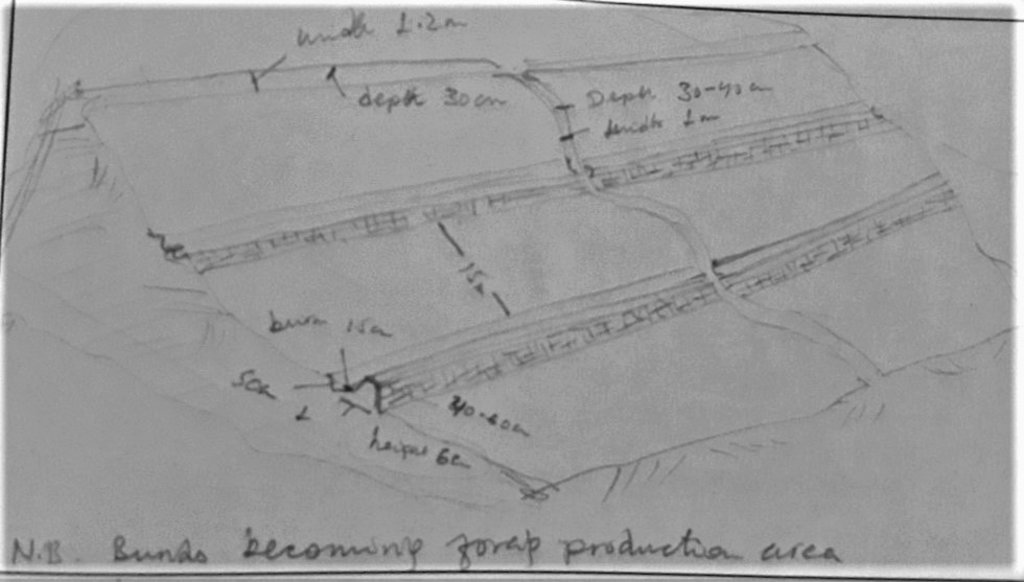Integrated Farm Land Conservation [เอธิโอเปีย]
- ผู้สร้างสรรค์:
- การอัพเดท:
- ผู้รวบรวม: Yismaw Wuletaw
- ผู้เรียบเรียง: –
- ผู้ตรวจสอบ: Tatenda Lemann
የተቀናጀ የእርሻ መሬት እንክብካቤ (yetekenaje yeirsha meriet inkibikabie)
technologies_4136 - เอธิโอเปีย
ดูส่วนย่อย
ขยายทั้งหมด ย่อทั้งหมด1. ข้อมูลทั่วไป
1.2 รายละเอียดที่ติดต่อได้ของผู้รวบรวมและองค์กรที่เกี่ยวข้องในการประเมินและการจัดเตรียมทำเอกสารของเทคโนโลยี
วิทยากรหลัก
ผู้ใช้ที่ดิน:
Debeb Belete
Abagerima Kebele Association
เอธิโอเปีย
ผู้เชี่ยวชาญ SLM:
ชื่อของโครงการซึ่งอำนวยความสะดวกในการทำเอกสารหรือการประเมินเทคโนโลยี (ถ้าเกี่ยวข้อง)
Carbon Benefits Project (CBP)ชื่อขององค์กรซึ่งอำนวยความสะดวกในการทำเอกสารหรือการประเมินเทคโนโลยี (ถ้าเกี่ยวข้อง)
Bureau of Agriculture - Amhara Nation Regional State - Bahir Dar (amhboard) - เอธิโอเปียชื่อขององค์กรซึ่งอำนวยความสะดวกในการทำเอกสารหรือการประเมินเทคโนโลยี (ถ้าเกี่ยวข้อง)
CDE Centre for Development and Environment (CDE Centre for Development and Environment) - สวิตเซอร์แลนด์ชื่อขององค์กรซึ่งอำนวยความสะดวกในการทำเอกสารหรือการประเมินเทคโนโลยี (ถ้าเกี่ยวข้อง)
Water and Land Resource Centre (WLRC) - เอธิโอเปีย1.3 เงื่อนไขการใช้ข้อมูลที่ได้บันทึกผ่านทาง WOCAT
ผู้รวบรวมและวิทยากรหลักยอมรับเงื่อนไขเกี่ยวกับการใช้ข้อมูลที่ถูกบันทึกผ่านทาง WOCAT:
ใช่
1.4 การเปิดเผยเรื่องความยั่งยืนของเทคโนโลยีที่ได้อธิบายไว้
เทคโนโลยีที่ได้อธิบายไว้นี้เป็นปัญหาของความเสื่อมโทรมโทรมของที่ดินหรือไม่ จึงไม่ได้รับการยอมรับว่าเป็นเทคโนโลยีเพื่อการจัดการที่ดินอย่างยั่งยืน:
ไม่ใช่
แสดงความคิดเห็น:
The technology is directly related land degradation and hence it can be declared as sustainable land management technology.
2. การอธิบายลักษณะของเทคโนโลยี SLM
2.1 การอธิบายแบบสั้น ๆ ของเทคโนโลยี
คำจำกัดความของเทคโนโลยี:
Integrated Farm Land Conservation (IFLC) comprises of farm terrace (bund) construction, construction of drainage structures, bund stabilization and livestock exclosure,
2.2 การอธิบายแบบละเอียดของเทคโนโลยี
คำอธิบาย:
Integrated Farm Land Conservation (IFLC) is practiced within a watershed on individual farmland. Main characteristics of the technology are conserving soil and moisture and at the same time safe disposal of excess runoff.
Farm terrace construction is actually terrace development, starting with soil or stone bunding that enables the development of a terrace, i.e. bench formation due to soil erosion, sediment deposition and tillage movement through time (5-15 years). The bunds are levelled or graded, the walls having a bottom width of 0.8 - 1.0 m, and a top width of about 0.4 m, the bund height is up to 0.6 m. Bunds are constructed parallel to the slope or slightly graded, on slopes ranging from 8 - 20 % gradients, and at a the vertical interval of 1-2 m between two bunds. The bunds are stabilized with vegetative measures like grass and legume shrubs. The drainage structures consist of the ditch along bunds, cut-off drains above cultivated land and waterways through it, the depth of a cut-off drain being 0.3 - 0.4 m and the average width 1.5 m, the depth of the waterway being 0.3 - 0.5 m, and the width of the waterway being 1.5 - 2 m. For bund and terrace protection in the initial years, livestock is excluded and farmers exercise cut and carry. Livestock exclosure encourages land users to practice crop residue management.
The purpose of the technology, in general, is to conserve soil and water, minimizing slope gradients of the farmland, improve soil moisture, reduce compaction, enhance infiltration and thus improve the recharge of groundwater. Furthermore, livestock exclosure contributes to soil fertility enhancement following crop residue management. The technology initially maintains soil fertility and through time, it has its own contribution to the betterment / increment of crop yield. Nevertheless some farmers complain about the land being occupied by the bunds, although this is later on compensated, as forage can be produced on the riser slopes of the growing terraces.
2.3 รูปภาพของเทคโนโลยี
คำอธิบายภาพ:
The photos were all taken during field work on 24 October 2018, while several technologies were assessed by different compilers. In the Abagerima area a full watershed was developed in 2013 by the Water and Land Resource Centre, Addis Ababa University and Centre for Development and Environment (CDE), University of Bern, funded by Swiss Development Cooperation and its Ethiopian partners.
2.5 ประเทศภูมิภาค หรือสถานที่ตั้งที่เทคโนโลยีได้นำไปใช้และได้รับการครอบคลุมโดยการประเมินนี้
ประเทศ:
เอธิโอเปีย
ภูมิภาค/รัฐ/จังหวัด:
Amhara Region, Ethiopia
ข้อมูลจำเพาะเพิ่มเติมของสถานที่ตั้ง :
Abagerima Watershed in the Highlands of Ethiopia
ระบุการกระจายตัวของเทคโนโลยี:
- กระจายไปอย่างสม่ำเสมอในพื้นที่
If the Technology is evenly spread over an area, specify area covered (in km2):
3.0
If precise area is not known, indicate approximate area covered:
- 1-10 ตร.กม.
Is/are the technology site(s) located in a permanently protected area?
ไม่ใช่
แสดงความคิดเห็น:
The site is not permanently protected. The site faced some damage due on and off free grazing instead of consistently exercising cut and carry practice. In some cases deliberate damage caused by few individuals by freely grazed the site.
Map
×2.6 วันที่การดำเนินการ
ระบุปีที่ใช้:
2013
ถ้าไม่รู้ปีที่แน่นอน ให้ระบุวันที่โดยประมาณ:
- น้อยกว่า 10 ปี (ไม่นานนี้)
2.7 คำแนะนำของเทคโนโลยี
ให้ระบุว่าเทคโนโลยีถูกแนะนำเข้ามาอย่างไร:
- ทางโครงการหรือจากภายนอก
- Government led community free labor mobilization for the natural resource conservation measures
ความคิดเห็น (ประเภทของโครงการ เป็นต้น) :
Government-led community free labor mobilization for the natural resource conservation measures, supported by Water and Land Resource Centre, Addis Ababa University and Centre for Development and Environment, University of Bern.
3. การจัดประเภทของเทคโนโลยี SLM
3.1 วัตถุประสงค์หลักของเทคโนโลยี
- ปรับปรุงการผลิตให้ดีขึ้น
- ลด ป้องกัน ฟื้นฟู การเสื่อมโทรมของที่ดิน
- ป้องกันพื้นที่ลุ่มน้ำ/บริเวณท้ายน้ำ โดยร่วมกับเทคโนโลยีอื่นๆ
- ปรับตัวเข้ากับการเปลี่ยนแปลงภูมิอากาศของโลก สภาพภูมิอากาศที่รุนแรงและผลกระทบ
- สร้างผลกระทบทางด้านเศรษฐกิจที่เป็นประโยชน์
3.2 ประเภทของการใช้ที่ดินในปัจจุบันที่ได้นำเทคโนโลยีไปใช้
Land use mixed within the same land unit:
ใช่
Specify mixed land use (crops/ grazing/ trees):
- การปลูกพืชร่วมกับปศุสัตว์และการทำป่าไม้ (Agro-silvopastoralism)

พื้นที่ปลูกพืช
- การปลูกพืชล้มลุกอายุปีเดียว
- การปลูกพืชยืนต้นที่ไม่มีเนื้อไม้
- การปลูกไม้ยืนต้น ไม้พุ่ม
Annual cropping - Specify crops:
- cereals - maize
- cereals - wheat (winter)
- legumes and pulses - other
- teff
Annual cropping system:
Continuous wheat/barley/oats/upland rice
Tree and shrub cropping - Specify crops:
- avocado
- coffee, shade grown
- mango, mangosteen, guava
- papaya
- Dodonaea angustifolia, Rhamnus Prinoides, Catha edulis
จำนวนของฤดูเพาะปลูกต่อปี:
- 1
Is intercropping practiced?
ไม่ใช่
Is crop rotation practiced?
ใช่
ถ้าใช่ ระบุ:
maize followed by pulses followed by wheat followed by teff, and rarely, fallow.

ทุ่งหญ้าเลี้ยงสัตว์
ทุ่งหญ้าเลี้ยงสัตว์ที่มีการจัดการแบบเข้มข้นหรือการผลิตอาหารสัตว์:
- ตัดแล้วขนไป / ไม่มีการปล่อยแทะเล็มเอง (Cut-and-carry / zero grazing)
Animal type:
- cattle - dairy
- cattle - non-dairy working
- goats
- mules and asses
- poultry
- sheep
- Bees
Is integrated crop-livestock management practiced?
ใช่
ถ้าใช่ ระบุ:
cattle is mainly used for ploughing (oxen), sheep and goats for meat.
ผลิตภัณฑ์และบริการ:
- meat
- milk
- transport/ draught
Species:
cattle - non-dairy working
Count:
2500
Species:
goats
Count:
830
Species:
sheep
Count:
2000
Species:
poultry
Count:
10200
Species:
mules and asses
Count:
1064

ป่า/พื้นที่ทำไม้
- ป่ากึ่งธรรมชาติ / พื้นที่ทำไม้
- ป่า/พื้นที่ทำไม้
(Semi-)natural forests/ woodlands: Specify management type:
- การเอาไม้ที่ตายแล้วออกไปหรือการตัดแต่งกิ่ง
- การใช้ประโยชน์จากป่า ยกเว้นไม้
Type of (semi-)natural forest:
- tropical moist deciduous forest natural vegetation
Tree plantation, afforestation: Specify origin and composition of species:
- การปลูกพืชพันธุ์ต่างถิ่นชนิดเดียว
- การปลูกหลายพันธุ์รวมกัน
Type of tree plantation, afforestation:
- tropical mountain systems plantation
Type of tree:
- Acacia species
- Eucalyptus globulus
- Cordia Africana, Olea african, Ficus vasta, Croton macrostachyus
Are the trees specified above deciduous or evergreen?
- mixed deciduous/ evergreen
ผลิตภัณฑ์และบริการ:
- ไม้ซุง
- ไม้ที่นำมาทำเป็นเชื้อเพลิง
- การแทะเล็มหญ้า / การเก็บกินหญ้า
แสดงความคิดเห็น:
Livestock population data for the whole watershed
3.3 Has land use changed due to the implementation of the Technology?
Has land use changed due to the implementation of the Technology?
- Yes (Please fill out the questions below with regard to the land use before implementation of the Technology)
Land use mixed within the same land unit:
ใช่
Specify mixed land use (crops/ grazing/ trees):
- การปลูกพืชร่วมกับปศุสัตว์และการทำป่าไม้ (Agro-silvopastoralism)

พื้นที่ปลูกพืช
- การปลูกพืชล้มลุกอายุปีเดียว
- การปลูกพืชยืนต้นที่ไม่มีเนื้อไม้
- การปลูกไม้ยืนต้น ไม้พุ่ม
Annual cropping - Specify crops:
- cereals - maize
- cereals - wheat (winter)
- legumes and pulses - other
- teff
Annual cropping system:
Continuous wheat/barley/oats/upland rice
Tree and shrub cropping - Specify crops:
- coffee, shade grown
- Dodonaea angustifolia, Rhamnus Prinoides, Catha edulis
Is intercropping practiced?
ไม่ใช่
Is crop rotation practiced?
ใช่
ถ้าใช่ ระบุ:
maize followed by pulses followed by wheat followed by teff, and rarely, fallow

ทุ่งหญ้าเลี้ยงสัตว์
Extensive grazing:
- กึ่งโนแมนดิซึ่มหรือแพสโตแรลลิซึ่ม (Semi-nomadism/pastoralism)
- การทำฟาร์มปศุสัตว์ (Ranching)
Animal type:
- cattle - non-dairy working
- goats
- sheep
Is integrated crop-livestock management practiced?
ใช่
ถ้าใช่ ระบุ:
livestock was allowed to graze all over the place before conservation, except on cultivated land during the growing season.
ผลิตภัณฑ์และบริการ:
- meat
- milk
- transport/ draught

ป่า/พื้นที่ทำไม้
- ป่ากึ่งธรรมชาติ / พื้นที่ทำไม้
(Semi-)natural forests/ woodlands: Specify management type:
- การตัดหมด (Clear felling)
- การเอาไม้ที่ตายแล้วออกไปหรือการตัดแต่งกิ่ง
Type of (semi-)natural forest:
- tropical mountain systems natural vegetation
Type of tree:
- Acacia species
- Eucalyptus globulus
Are the trees specified above deciduous or evergreen?
- mixed deciduous/ evergreen
ผลิตภัณฑ์และบริการ:
- ไม้ซุง
- ไม้ที่นำมาทำเป็นเชื้อเพลิง
- การแทะเล็มหญ้า / การเก็บกินหญ้า
แสดงความคิดเห็น:
Land use change (of Abagerima watershed over the intervention periods (2010 and 2017):
Land use change Ha.
Cultivated land to bush/ shrub land4.1
Cultivated land to degraded grass land 3.9
Cultivated land to grass land 5.8
Cultivated land to Homestead 8.0
Cultivated land to plantation 4.9
Degraded grass land to bush/ shrub land 1.2
Grass land to bush/ shrub land 3.2
Grass land to cultivated land 6.1
Grass land to degraded grass land 4.0
Grass land to riverine vegetation1.2
Source: - Achievements and Impacts of Learning Watershed Approach: Technologies, Innovations and Evidence for Scaling up WLRC Research Report 3, Addis Ababa University, 2019, Addis Ababa
3.4 การใช้น้ำ
การใช้น้ำของที่ดินที่มีการใช้เทคโนโลยีอยู่:
- จากน้ำฝน
แสดงความคิดเห็น:
cropping is based mainly on rain-fed, farmers utilize groundwater for perennial crop production on a small scale in their homestead development areas
3.5 กลุ่ม SLM ที่ตรงกับเทคโนโลยีนี้
- การปิดล้อมพื้นที่ (หยุดการใช้ประโยชน์ สนับสนุนการฟื้นฟู)
- การจัดการปลูกพืชร่วมกับปศุสัตว์
- การผันน้ำและการระบายน้ำ
3.6 มาตรการ SLM ที่ประกอบกันเป็นเทคโนโลยี

มาตรการจัดการพืช
- A2: อินทรียวัตถุในดิน/ความอุดมสมบูรณ์ในดิน
- A5: การจัดการเมล็ดพันธุ์ การปรับปรุงพันธุ์
- A6: Residue management
A6: Specify residue management:
A 6.4: retained

มาตรการอนุรักษ์ด้วยวิธีพืช
- V2: หญ้าและไม้ยืนต้น

มาตรการอนุรักษ์ด้วยโครงสร้าง
- S1: คันดิน
- S2: ทำนบ เขื่อนดิน
- S3: Graded ditches, channels, waterways
- S4: คูน้ำแนวระดับ หลุม

มาตรการอนุรักษ์ด้วยการจัดการ
- M1: การเปลี่ยนรูปแบบของการใช้ประโยชน์ที่ดิน
- M2: การเปลี่ยนแปลงของการจัดการหรือระดับความเข้มข้น
3.7 รูปแบบหลักของการเสื่อมโทรมของที่ดินที่ได้รับการแก้ไขโดยเทคโนโลยี

การกัดกร่อนของดินโดยน้ำ
- Wt (Loss of topsoil): การสูญเสียดินชั้นบนหรือการกัดกร่อนที่ผิวดิน
- Wg (Gully erosion): การกัดกร่อนแบบร่องธารหรือการทำให้เกิดร่องน้ำเซาะ
- Wr (Riverbank erosion): การกัดกร่อนริมฝั่งแม่น้ำ
- Wo (Offsite degradation): ผลกระทบนอกพื้นที่

การเสื่อมโทรมของดินทางด้านกายภาพ
- Pc (Compaction): การอัดแน่น
- Pi (Soil sealing)

การเสื่อมโทรมของดินทางด้านชีวภาพ
- Bc (Reduction of vegetation cover): การลดลงของจำนวนพืชที่ปกคลุมดิน
- Bh (Loss of habitat): การสูญเสียแหล่งที่อยู่
- Bl (Loss of soil life): การสูญเสียสิ่งมีชีวิตในดิน
- Bp (Increase of pests/diseases): การเพิ่มขึ้นของศัตรูพืชและโรคพืช

การเสื่อมโทรมของน้ำ
- Hs (Change in quantity of surface water): การเปลี่ยนแปลงปริมาณของน้ำที่ผิวดิน
- Hg (Change in groundwater): การเปลี่ยนแปลงของน้ำบาดาลหรือระดับน้ำในแอ่งน้ำบาดาล
- Hp (Decline of surface water quality): การลดลงของคุณภาพน้ำที่ผิวดิน
- Hq (Decline of groundwater quality): การลดลงของคุณภาพน้ำบาดาล
3.8 การป้องกัน การลดลง หรือการฟื้นฟูความเสื่อมโทรมของที่ดิน
ระบุเป้าหมายของเทคโนโลยีกับความเสื่อมโทรมของที่ดิน:
- ป้องกันความเสื่อมโทรมของที่ดิน
- ฟื้นฟูบำบัดที่ดินที่เสื่อมโทรมลงอย่างมาก
4. ข้อมูลจำเพาะด้านเทคนิค กิจกรรมการนำไปปฏิบัติใช้ ปัจจัยนำเข้า และค่าใช้จ่าย
4.1 แบบแปลนทางเทคนิคของเทคโนโลยี
ข้อมูลจำเพาะด้านเทคนิค (แบบแปลนทางเทคนิคของเทคโนโลยี):
The height of the bund is less than 0.6 m, the width of the bund is less than 1.6 m, the average slope is 8 - 15 %, the veritcal interval between two bunds is 1- 2 m, and the average spacing between structures is about 15 m
ผู้เขียน:
Yismaw Wuletaw
วันที่:
24/10/2018
4.2 ข้อมูลทั่วไปเกี่ยวกับการคำนวณปัจจัยนำเข้าและค่าใช้จ่าย
ให้ระบุว่าค่าใช้จ่ายและปัจจัยนำเข้าได้รับการคำนวณอย่างไร:
- ต่อพื้นที่ที่ใช้เทคโนโลยี
ระบุขนาดและหน่วยพื้นที่:
300 ha
ระบุสกุลเงินที่ใช้คำนวณค่าใช้จ่าย:
- USD
If relevant, indicate exchange rate from USD to local currency (e.g. 1 USD = 79.9 Brazilian Real): 1 USD =:
1.0
ระบุค่าเฉลี่ยของค่าจ้างในการจ้างแรงงานต่อวัน:
3 USD
4.3 กิจกรรมเพื่อการจัดตั้ง
| กิจกรรม | Timing (season) | |
|---|---|---|
| 1. | Cutoff drain | After crop harvesting |
| 2. | Waterway | After crop harvesting |
| 3. | Stone-faced soil bund | After crop harvesting |
| 4. | Bund stabilization | At the onset of the rainy season |
4.4 ค่าใช้จ่ายของปัจจัยนำเข้าที่จำเป็นสำหรับการจัดตั้ง
| ปัจจัยนำเข้า | หน่วย | ปริมาณ | ค่าใช้จ่ายต่อหน่วย | ค่าใช้จ่ายทั้งหมดต่อปัจจัยนำเข้า | %ของค่าใช้จ่ายที่ก่อให้เกิดขึ้นโดยผู้ใช้ที่ดิน | |
|---|---|---|---|---|---|---|
| แรงงาน | cutoff-off drain | Person day | 2600.0 | 3.0 | 7800.0 | 1.0 |
| แรงงาน | Waterway | Person day | 3500.0 | 3.0 | 10500.0 | 1.0 |
| แรงงาน | Stone-faced soil bund | Person day | 14100.0 | 3.0 | 42300.0 | 1.0 |
| แรงงาน | Bund stabilization | Person day | 1500.0 | 3.0 | 4500.0 | 1.0 |
| อื่น ๆ | Hand tools (shovel, pick-ax) | No | 1080.0 | 2.89 | 3121.2 | 0.0 |
| อื่น ๆ | Water level | No | 24.0 | 2.17 | 52.08 | 0.0 |
| ค่าใช้จ่ายทั้งหมดของการจัดตั้งเทคโนโลยี | 68273.28 | |||||
| Total costs for establishment of the Technology in USD | 68273.28 | |||||
ถ้าผู้ใช้ที่ดินรับภาระน้อยกว่า 100% ของค่าใช้จ่าย ให้ระบุว่าใครเป็นผู้รับผิดชอบส่วนที่เหลือ:
Government-led community free labor mobilization for the natural resource conservation measures, supported by Water and Land Resource Centre, Addis Ababa University and Centre for Development and Environment, University of Bern.
แสดงความคิดเห็น:
The community contributed free labor contribution. The government and Water and Land Resource Center provided technical(capacity building and monitoring) and input support.
According to the 2019 Project unpublished report, the total person days (pds) for Abagerima Community Watershed is 181,920 and for Integrated Farm land Conservation approximately 43,400 person days (Source: Gombat and Laguna Kebele level Office of Agriculture). By virtue, the community contributed their labour almost for half working day (four hours) the total person days have been divided by 2 and multiplied by 3 USD (which is the approximate daily rate).
Regarding the tool cost, the cost was covered by the government and the project (WLRC).
4.5 การบำรุงรักษาสภาพหรือกิจกรรมที่เกิดขึ้นเป็นประจำ
| กิจกรรม | ช่วงระยะเวลา/ความถี่ | |
|---|---|---|
| 1. | Cutoff drain | After crop harvesting |
| 2. | Waterway | After crop harvesting |
| 3. | Stone-faced soil bund | After crop harvesting |
| 4. | Bund stabilization | At the onset of the rain |
4.6 ค่าใช้จ่ายของปัจจัยนำเข้าและกิจกรรมที่เกิดขึ้นเป็นประจำที่ต้องการการบำรุงรักษา (ต่อปี)
| ปัจจัยนำเข้า | หน่วย | ปริมาณ | ค่าใช้จ่ายต่อหน่วย | ค่าใช้จ่ายทั้งหมดต่อปัจจัยนำเข้า | %ของค่าใช้จ่ายที่ก่อให้เกิดขึ้นโดยผู้ใช้ที่ดิน | |
|---|---|---|---|---|---|---|
| แรงงาน | Stone faced soil bund | person day | 10000.0 | 3.0 | 30000.0 | 1.0 |
| แรงงาน | Bund stabilization | person day | 200.0 | 3.0 | 600.0 | 10.0 |
| ค่าใช้จ่ายทั้งหมดของการบำรุงรักษาสภาพเทคโนโลยี | 30600.0 | |||||
| Total costs for maintenance of the Technology in USD | 30600.0 | |||||
ถ้าผู้ใช้ที่ดินรับภาระน้อยกว่า 100% ของค่าใช้จ่าย ให้ระบุว่าใครเป็นผู้รับผิดชอบส่วนที่เหลือ:
The community contributed free labor contribution. The WLRC provided capacity development and input support.
4.7 ปัจจัยสำคัญที่สุดที่มีผลกระทบต่อค่าใช้จ่าย
ปัจจัยสำคัญที่สุดที่มีผลกระทบต่อค่าใช้จ่ายต่างๆ:
The season, as especially during sowing, weeding and harvesting times the labour costs are scarce and hence, high.
5. สิ่งแวดล้อมทางธรรมชาติและของมนุษย์
5.1 ภูมิอากาศ
ฝนประจำปี
- < 250 ม.ม.
- 251-500 ม.ม.
- 501-750 ม.ม.
- 751-1,000 ม.ม.
- 1,001-1,500 ม.ม.
- 1,501-2,000 ม.ม.
- 2,001-3,000 ม.ม.
- 3,001-4,000 ม.ม.
- > 4,000 ม.ม.
เขตภูมิอากาศเกษตร
- กึ่งชุ่มชื้น
5.2 สภาพภูมิประเทศ
ค่าเฉลี่ยความลาดชัน:
- ราบเรียบ (0-2%)
- ลาดที่ไม่ชัน (3-5%)
- ปานกลาง (6-10%)
- เป็นลูกคลื่น (11-15%)
- เป็นเนิน (16-30%)
- ชัน (31-60%)
- ชันมาก (>60%)
ธรณีสัณฐาน:
- ที่ราบสูง/ที่ราบ
- สันเขา
- ไหล่เขา
- ไหล่เนินเขา
- ตีนเนิน
- หุบเขา
ระดับความสูง:
- 0-100 เมตร
- 101-500 เมตร
- 501-1,000 เมตร
- 1,001-1,500 เมตร
- 1,501-2,000 เมตร
- 2,001-2,500 เมตร
- 2,501-3,000 เมตร
- 3,001-4,000 เมตร
- > 4,000 เมตร
ให้ระบุถ้าเทคโนโลยีได้ถูกนำไปใช้:
- ไม่เกี่ยวข้อง
5.3 ดิน
ค่าเฉลี่ยความลึกของดิน:
- ตื้นมาก (0-20 ซ.ม.)
- ตื้น (21-50 ซ.ม.)
- ลึกปานกลาง (51-80 ซ.ม.)
- ลึก (81-120 ซ.ม.)
- ลึกมาก (>120 ซ.ม.)
เนื้อดิน (ดินชั้นบน):
- ปานกลาง (ดินร่วน ทรายแป้ง)
เนื้อดินล่าง (> 20 ซ.ม.ต่ำจากผิวดิน):
- ปานกลาง (ดินร่วน ทรายแป้ง)
- ละเอียด/หนัก (ดินเหนียว)
อินทรียวัตถุในดิน:
- ปานกลาง (1-3%)
- ต่ำ (<1%)
5.4 ความเป็นประโยชน์และคุณภาพของน้ำ
ระดับน้ำใต้ดิน:
<5 เมตร
น้ำไหลบ่าที่ผิวดิน:
ปานกลาง
คุณภาพน้ำ (ที่ยังไม่ได้บำบัด):
เป็นน้ำเพื่อการดื่มที่ไม่ดี (จำเป็นต้องได้รับการบำบัด)
Water quality refers to:
surface water
ความเค็มของน้ำเป็นปัญหาหรือไม่:
ไม่ใช่
กำลังเกิดน้ำท่วมในพื้นที่หรือไม่:
ไม่ใช่
5.5 ความหลากหลายทางชีวภาพ
ความหลากหลายทางชนิดพันธุ์:
- ต่ำ
ความหลากหลายของแหล่งที่อยู่:
- ต่ำ
5.6 ลักษณะของผู้ใช้ที่ดินที่นำเทคโนโลยีไปปฏิบัติใช้
อยู่กับที่หรือเร่ร่อน:
- อยู่กับที่
แนวทางการตลาดของระบบการผลิต:
- mixed (subsistence/ commercial)
รายได้ที่มาจากนอกฟาร์ม:
- < 10% ของรายได้ทั้งหมด
ระดับของความมั่งคั่งโดยเปรียบเทียบ:
- จน
- พอมีพอกิน
เป็นรายบุคคล/ครัวเรือน:
- เป็นรายบุคคล/ครัวเรือน
ระดับของการใช้เครื่องจักรกล:
- งานที่ใช้แรงกาย
- การใช้กำลังจากสัตว์
เพศ:
- หญิง
- ชาย
อายุของผู้ใช้ที่ดิน:
- ผู้เยาว์
- วัยกลางคน
5.7 Average area of land used by land users applying the Technology
- < 0.5 เฮกตาร์
- 0.5-1 เฮกตาร์
- 1-2 เฮกตาร์
- 2-5 เฮกตาร์
- 5-15 เฮกตาร์
- 15-50 เฮกตาร์
- 50-100 เฮกตาร์
- 100-500 เฮกตาร์
- 500-1,000 เฮกตาร์
- 1,000-10,000 เฮกตาร์
- >10,000 เฮกตาร์
พิจารณาว่าเป็นขนาดเล็ก กลาง หรือขนาดใหญ่ (ซึ่งอ้างอิงถึงบริบทระดับท้องถิ่น):
- ขนาดเล็ก
5.8 กรรมสิทธิ์ในที่ดิน สิทธิในการใช้ที่ดินและสิทธิในการใช้น้ำ
กรรมสิทธิ์ในที่ดิน:
- รัฐ
- รายบุคคล ได้รับสิทธิครอบครอง
สิทธิในการใช้ที่ดิน:
- เกี่ยวกับชุมชน (ถูกจัดระเบียบ)
- รายบุคคล
สิทธิในการใช้น้ำ:
- เข้าถึงได้แบบเปิด (ไม่ได้จัดระเบียบ)
- รายบุคคล
Are land use rights based on a traditional legal system?
ไม่ใช่
แสดงความคิดเห็น:
In case of drinking water, there is some organization to manage the resource
5.9 การเข้าถึงบริการและโครงสร้างพื้นฐาน
สุขภาพ:
- จน
- ปานกลาง
- ดี
การศึกษา:
- จน
- ปานกลาง
- ดี
ความช่วยเหลือทางด้านเทคนิค:
- จน
- ปานกลาง
- ดี
การจ้างงาน (เช่น ภายนอกฟาร์ม):
- จน
- ปานกลาง
- ดี
ตลาด:
- จน
- ปานกลาง
- ดี
พลังงาน:
- จน
- ปานกลาง
- ดี
ถนนและการขนส่ง:
- จน
- ปานกลาง
- ดี
น้ำดื่มและการสุขาภิบาล:
- จน
- ปานกลาง
- ดี
บริการด้านการเงิน:
- จน
- ปานกลาง
- ดี
6. ผลกระทบและสรุปคำบอกกล่าว
6.1 ผลกระทบในพื้นที่ดำเนินการ (On-site) จากการใช้เทคโนโลยี
ผลกระทบทางด้านเศรษฐกิจและสังคม
การผลิต
การผลิตพืชผล
แสดงความคิดเห็น/ระบุ:
It is because of integrated farmland conservation measures and improved use of agricultural input
คุณภาพพืชผล
การผลิตพืชที่ใช้เลี้ยงปศุสัตว์
คุณภาพพืชที่ใช้เลี้ยงปศุสัตว์
แสดงความคิดเห็น/ระบุ:
Weed also grows together with forage grass and reduces the quality of grass.
การผลิตสัตว์
การผลิตไม้
คุณภาพป่า /พื้นที่ทำไม้
การผลิตของจากป่าทุกชนิดยกเว้นไม้
การเสี่ยงต่อความล้มเหลวในการผลิต
ความหลากหลายของผลิตภัณฑ์
พื้นที่สำหรับการผลิต
การจัดการที่ดิน
ความเป็นประโยชน์และคุณภาพของน้ำ
การมีน้ำดื่มไว้ให้ใช้
คุณภาพน้ำดื่ม
การมีน้ำไว้ให้ปศุสัตว์
คุณภาพน้ำสำหรับปศุสัตว์
การมีน้ำไว้ให้สำหรับการชลประทาน
คุณภาพน้ำสำหรับการชลประทาน
ความต้องการน้ำจากการชลประทาน
รายได้และค่าใช้จ่าย
ค่าใช่จ่ายของปัจจัยการผลิตทางการเกษตร
รายได้จากฟาร์ม
ความหลากหลายของแหล่งผลิตรายได้
ความเหลื่อมล้ำทางเศรษฐกิจ
ภาระงาน
ผลกระทบด้านสังคมวัฒนธรรมอื่น ๆ
ความมั่นคงด้านอาหาร / พึ่งตนเองได้
สถานการณ์ด้านสุขภาพ
การใช้ที่ดิน / สิทธิในการใช้น้ำ
สถาบันของชุมชน
SLM หรือความรู้เรื่องความเสื่อมโทรมของที่ดิน
การบรรเทาความขัดแย้ง
สถานการณ์ของกลุ่มด้อยโอกาส ทางด้านสังคมและเศรษฐกิจ
ผลกระทบด้านนิเวศวิทยา
วัฐจักรน้ำหรือน้ำบ่า
ปริมาณน้ำ
คุณภาพน้ำ
การเก็บเกี่ยวหรือการกักเก็บน้ำ
น้ำไหลบ่าที่ผิวดิน
การระบายน้ำส่วนเกิน
น้ำบาดาลหรือระดับน้ำในแอ่งน้ำบาดาล
การระเหย
แสดงความคิดเห็น/ระบุ:
This includes evapotranspiration
ดิน
ความชื้นในดิน
สิ่งปกคลุมดิน
การสูญเสียดิน
การสะสมของดิน
การเกิดแผ่นแข็งที่ผิวดิน /การเกิดชั้นดาน
การอัดแน่นของดิน
การหมุนเวียนและการเติมของธาตุอาหาร
แสดงความคิดเห็น/ระบุ:
Crop residue management following livestock exclosure from the farmland.
ความเค็ม
อินทรียวัตถุในดิน/ต่ำกว่าดินชั้น C
ความเป็นกรด
ความหลากหลายทางชีวภาพของพืชและสัตว์
การปกคลุมด้วยพืช
มวลชีวภาพ/เหนือดินชั้น C
ความหลากหลายทางชีวภาพของพืช
พืชพันธุ์ต่างถิ่นที่รุกล้ำเข้ามา
แสดงความคิดเห็น/ระบุ:
Not alien species, but the common weed species getting spread.
ความหลากหลายทางชีวภาพของสัตว์
ชนิดพันธุ์ที่ให้ประโยชน์
แสดงความคิดเห็น/ระบุ:
But the bee colony is getting decreased due to the use of pesticide and insecticide.
ความหลากหลายของสัตว์
การจัดการศัตรูพืชและโรคพืช
ลดความเสี่ยงของภัยพิบัติ
ผลกระทบจากน้ำท่วม
ดินถล่ม/ ซากต่าง ๆ ที่ถูกพัดพามา
ผลกระทบจากภัยแล้ง
ผลกระทบของพายุไซโคลน พายุฝน
การปล่อยคาร์บอนและก๊าซเรือนกระจก
แสดงความคิดเห็น/ระบุ:
Due to minimizing the number of livestock from time to time. It is due to the fact that farmers are unable to manage under better/ intensive management following controlled grazing.
ความเสี่ยงจากไฟ
ความเร็วของลม
ภูมิอากาศจุลภาค
6.2 ผลกระทบนอกพื้นที่ดำเนินการ (Off-site) จากการใช้เทคโนโลยี
น้ำที่ใช้ประโยชน์ได้
การไหลของน้ำคงที่และสม่ำเสมอในช่วงฤดูแล้ง
แสดงความคิดเห็น/ระบุ:
Seasonal streams apparently have runoff longer into the dry season than before soil and water conservation, according to land users' observations.
น้ำท่วมพื้นที่ท้ายน้ำ
การทับถมของดินตะกอนพื้นที่ท้ายน้ำ
การเกิดมลพิษในน้ำบาดาลหรือแม่น้ำ
ความสามารถต้านทานการเปลี่ยนแปลง / ความสามารถในการคัดกรอง
ตะกอนที่ถูกพัดพามาโดยลม
ความเสียหายต่อพื้นที่เพาะปลูกของเพื่อนบ้าน
6.3 การเผชิญและความตอบสนองของเทคโนโลยีต่อการเปลี่ยนแปลงสภาพภูมิอากาศที่ค่อยเป็นค่อยไป และสภาพรุนแรงของภูมิอากาศ / ภัยพิบัติ (ที่รับรู้ได้โดยผู้ใช้ที่ดิน)
การเปลี่ยนแปลงสภาพภูมิอากาศที่ค่อยเป็นค่อยไป
การเปลี่ยนแปลงสภาพภูมิอากาศที่ค่อยเป็นค่อยไป
| ฤดู | increase or decrease | เทคโนโลยีมีวิธีการรับมืออย่างไร | |
|---|---|---|---|
| อุณหภูมิประจำปี | เพิ่มขึ้น | ดี | |
| อุณหภูมิตามฤดูกาล | ฤดูแล้ง | เพิ่มขึ้น | ดี |
| ฝนประจำปี | ดี |
สภาพรุนแรงของภูมิอากาศ (ภัยพิบัติ)
ภัยพิบัติทางอุตุนิยมวิทยา
| เทคโนโลยีมีวิธีการรับมืออย่างไร | |
|---|---|
| พายุเขตร้อน | ดี |
| พายุฝนประจำท้องถิ่น | ดี |
| พายุฝนฟ้าคะนองประจำท้องถิ่น | ปานกลาง |
| พายุลูกเห็บประจำท้องถิ่น | ปานกลาง |
6.4 การวิเคราะห์ค่าใช้จ่ายและผลประโยชน์ที่ได้รับ
ผลประโยชน์ที่ได้รับเปรียบเทียบกับค่าใช้จ่ายในการจัดตั้งเป็นอย่างไร (จากมุมมองของผู้ใช้ที่ดิน)
ผลตอบแทนระยะสั้น:
ด้านลบ
ผลตอบแทนระยะยาว:
ด้านบวก
ผลประโยชน์ที่ได้รับเปรียบเทียบกับค่าใช้จ่ายในการบำรุงรักษาหรือต้นทุนที่เกิดขึ้นซ้ำอีก เป็นอย่างไร (จากมุมมองของผู้ใช้ที่ดิน)
ผลตอบแทนระยะสั้น:
ด้านบวกเล็กน้อย
ผลตอบแทนระยะยาว:
ด้านบวก
แสดงความคิดเห็น:
The farmland owner considers "with" and "without" scenario and the comparative labour cost.
6.5 การปรับตัวของเทคโนโลยี
- > 50%
Of all those who have adopted the Technology, how many did so spontaneously, i.e. without receiving any material incentives/ payments?
- 91-100%
6.6 การปรับตัว
เทคโนโลยีได้รับการปรับเปลี่ยนเมื่อเร็วๆนี้ เพื่อให้ปรับตัวเข้ากับสภาพที่กำลังเปลี่ยนแปลงหรือไม่:
ไม่ใช่
6.7 จุดแข็ง / ข้อได้เปรียบ / โอกาสของเทคโนโลยี
| จุดแข็ง / ข้อได้เปรียบ / โอกาสในทัศนคติของผู้ใช้ที่ดิน |
|---|
| 1. Conserving the soil and water and hence reduce flood hazard, 2. Avoiding traditional ditches and minimizing conflict due flood, 3. Minimizing/ lowering the slope of the farmland, 4. Improving the surface and groundwater potential, 5. Contributing to the betterment of yield, |
| จุดแข็ง / ข้อได้เปรียบ / โอกาสในทัศนคติของผู้รวบรวมหรือวิทยากรหลัก |
|---|
| 1. Conserving the soil and water and hence reduce flood hazard, 2. Avoiding traditional ditches and minimizing conflict due flood, 3. Minimizing/ lowering the slope of the farmland, 4. Improving the surface and groundwater potential, 5. Maintain soil fertility and through time improves the fertility status, 6. Contributing to the betterment of yield. |
6.8 จุดอ่อน / ข้อเสียเปรียบ / ความเสี่ยงของเทคโนโลยีและวิธีการแก้ไข
| จุดอ่อน / ข้อเสียเปรียบ / ความเสี่ยงในทัศนคติของผู้ใช้ที่ดิน | มีวิธีการแก้ไขได้อย่างไร |
|---|---|
| Expansion of rodents, | Construction of ditches to protect rodents around the farm. |
| Land occupied by the structures. | Producing forage on the structures including bunds and drainage structures. |
| จุดอ่อน / ข้อเสียเปรียบ / ความเสี่ยงในทัศนคติของผู้รวบรวมหรือวิทยากรหลัก | มีวิธีการแก้ไขได้อย่างไร |
|---|---|
| Unable to utilize more the area occupied by the structure. | Considering agroclimatic situation of the area, there is an opportunity to produce high-value crops. So, better to consider forage, selected fruit or other trees that will produce short, medium and long-term benefits. |
| Limitation on integration of biological measures (agronomic measures), like green manuring, inter-cropping to improve soil fertility and hence minimize flood/erosion, and to improve productivity, | Providing inputs aiming at demonstrating how to practice green manuring (like Lupine, Sesbania sesban) and inter-cropping (like pigeon pea, which offers additional production besides to soil fertility). |
| Limitation, partially, on maintaining the interval between two successive bunds. | Establishing grass, bushes, fruit hedgerows in between two successive bunds. |
| Limitation on the number of tillage operations. | Minimizing the number of tillage for annual crop production not to further disturb soil aggregates and enhance sealing and run off. Better to consider conservation agriculture (CA) if capacity building and input provision is put in place for demonstration and dissemination. |
| Limitation on institutional capacity building (from the community watershed committee up to the regional and federal levels) regarding the concept of Integrated farm land conservation (the view is focused more on physical structures and to some extent on bund stabilization). | Building the capacity of the respective heads/ leaders/ community representatives on the role of integrating bio-physical and soil fertility enhancement measures so as to maximize the benefits of soil and moisture conservation, improve infiltration/ recharging, minimize soil erosion, enhance soil fertility and hence crop productivity in a sustained manner. Thus the contribution for carbon sequestration is also enhanced. |
| The declining trend in traditional crop rotation leads to soil fertility depletion and aggravates crop pests. | Improving soil fertility, use of input (selective crop varieties and organic and inorganic fertilizers), and improving the traditional crop rotation so as to minimize soil fertility depletion. |
7. การอ้างอิงและการเชื่อมต่อ
7.1 วิธีการและแหล่งข้อมูล
- ไปเยี่ยมชมภาคสนาม การสำรวจพื้นที่ภาคสนาม
Two
- การสัมภาษณ์กับผู้ใช้ที่ดิน
Mr. Belete Debeb
- การสัมภาษณ์ผู้เชี่ยวชาญด้าน SLM หรือผู้ชำนาญ
Mr. Melese Bililgin
วันที่เก็บรวบรวมข้อมูล(ภาคสนาม) :
24/10/2018
แสดงความคิดเห็น:
Transect walk was undertaken through the watershed. An interview was done with the land user.
7.2 การอ้างอิงถึงสิ่งตีพิมพ์
หัวข้อ, ผู้เขียน, ปี, หมายเลข ISBN:
Integrated Farm Land, Conservation, Yismaw Wuletaw, 2018
ชื่อเรื่อง ผู้เขียน ปี ISBN:
Can be obtained from author
7.3 Links to relevant online information
ชื่อเรื่องหรือคำอธิบาย:
none
URL:
-
7.4 General comments
The questionnaire is easily understood and can be filled provided that the information can be collected in the field or with informants.
General remark: The comments are forwarded, as observed at field, because when we talk about Integrated Farm Land Conservation (IFLC), it should be integrated as much as possible/ inclusive for better results, as the ultimate goals of IFLC are:
oEnvironmental benefits - Conserving soil and moisture, carbon sequestration, improving the local climate;
oEconomic benefits - improving crop productivity, generating forage as a result of structural stabilization, and if it is implemented in an organized manner, it can also generate further economic benefits from gesho, fruit and selected trees like Grevillea robusta and Acacia dicurrens planted on structures;
oSocial benefits – contributing to social prestige as a result of producing reasonable production (if the concept of “optimizing the productivity per unit area, water and time” is respected, the livelihood of the rural community is also improved simply due to maintaining healthy soil and use of input for structural stabilization – i.e making the structures productive. In advanced terms, if IFLC is implemented in a well organized manner, the production through protection concept will be maintained. Thus, IFLC will contribute to the stability of the community within their surroundings/ watersheds and enable the transferring healthy soil/ land for the next generation.
ลิงก์และโมดูล
ขยายทั้งหมด ย่อทั้งหมดลิงก์
ไม่มีลิงก์
โมดูล
ไม่มีโมดูล


